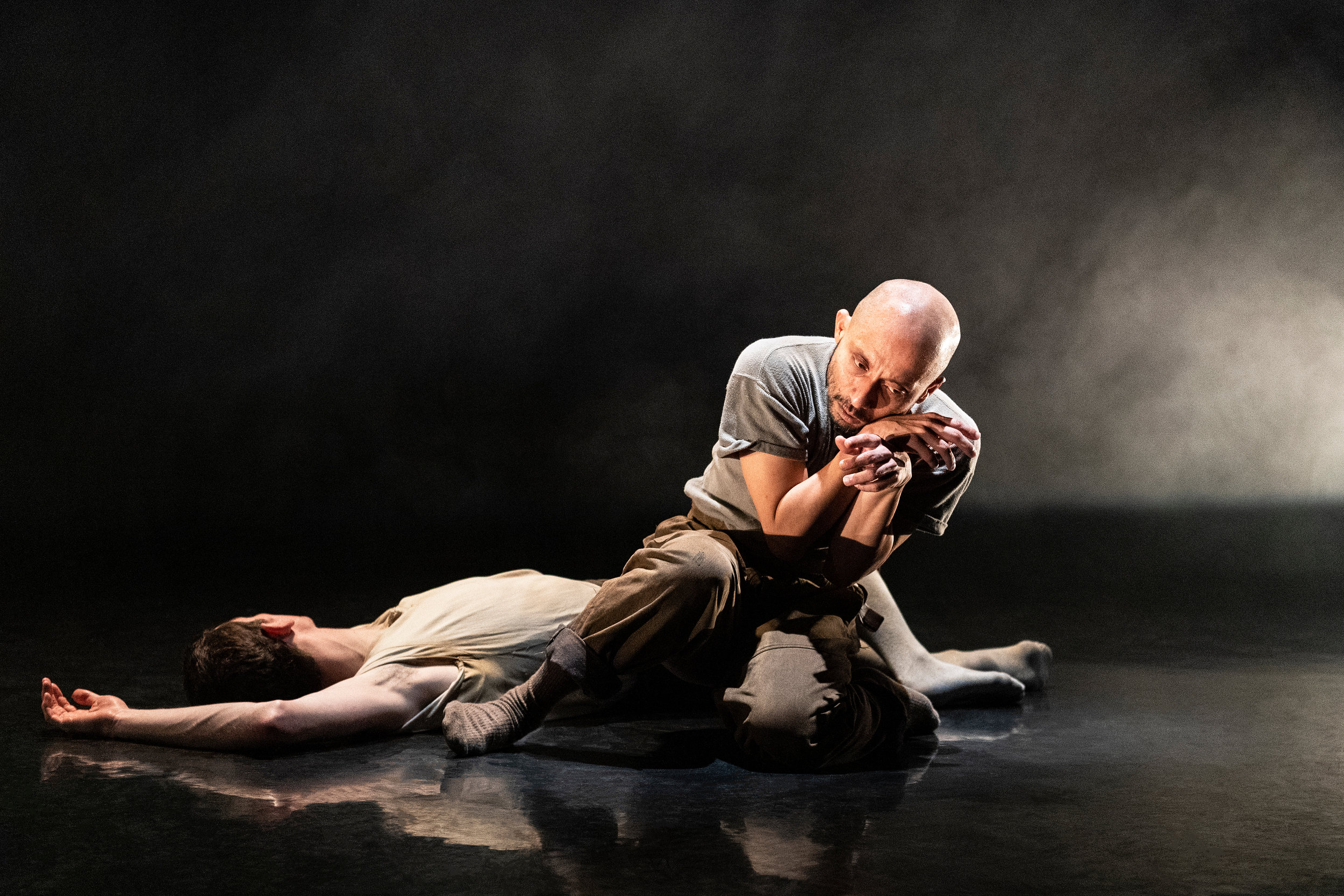Lover, Lover, Lover Come Back to Me
Mavin Khoo and Victor Callens in Man to Monk, Part One, by Carlos Pons Guerra. Photo: Christofilooulou Fonteini.
Lover, Lover, Lover Come Back to Me
By Carlos Pons Guerra
Both Mavin and I share an obsession with classicism, especially towards western classical dance. When we explored the deconstruction of the classical duet, the pas de deux, we were both intrigued by its own obsession with beauty, its compulsive need to validate the worth of its performers, and, in particular, that of the female dancer, in what can arguably be an unbalanced relationship.
It seemed inevitable to draw parallels with queer male relationships. Many of us, queer men, reach adulthood through a Calvary of rejection, fear, discrimination and often hiding. It is no surprise that in a partner we seek that arm that will promenade us and display a beauty that we cannot see in ourselves, that will support us in a lifelong adage that will give us the validation that was denied us growing up. This work draws on notions of classical partnering, where, having done aside with the gender binary roles of the pas de deux, we ask what happens when two men with their own emotional energy and baggage approach an iconic format of male-female relationships.
Heightened emotional states, for me, characterize this work. A hyperbolic depiction of emotion that I relate to the Hispanic culture to which I belong, but with which I found common ground when researching Mavin’s person and his own classical Indian dance repertory. Throughout the process of creation the joining of male energies created fervent emotive situations alike the melodrama, a genre I consider to be in my Latin DNA, and the epics from which Mavin’s repertory draws on. It was fascinating, as men, to be allowed to delve into these emotional extremes that we considered driving forces of human behaviour.
It was these extremes of emotion that led us to the concept of death, so present in both Mavin’s and my culture, but also so intimately related to desire. It is the frenzy of the need for validation and bodily ownership that pulls the trigger of Norma Desmond’s gun in Sunset Boulevard; when speaking of bullfighting, film director Pedro Almodovar talks of an extreme game that symbolizes a relationship beyond that of enemies, but that of a beastly passion that can only result in sacrifice, in a blood sport played out by two males. Sex, love and death seemed to me intricately connected, in the sacrifices one makes for love, and the death or elimination of the desire that ties us to earthly planes.
And so death, in this work, becomes a symbol for transcendence. Killing our lust for desire may lead us to new levels of maturity; but do we ever stop bearing the weighty cross of the corpses we accumulate? Imagery of enraged Hindu deities triumphantly stepping over the carcasses of demons illuminate and suggest that killing our darlings- living and embracing the Calvary of passions that makes us human, and engaging in a continuous cycle of emotional murder and rebirth- allows us to transcend, to grow, and to desire in new spheres of meaning.
When Mavin Khoo invited me to collaborate with him on Man to Monk: Part One, Man, I asked myself what to me defined the driving force of men, and my answer was desire. A guttural, innate force, a hunger for flesh that, identifying as such, I particularly related to queer male identity; an irrational, tremendously powerful force that moves us, with the power to create and destroy. Raised a Catholic, my religious upbringing always demanded I reject and avoided desire- especially homosexual desire. Through my initial conversations with Mavin, I was fascinated by exploring Sufi and Hindu concepts with him; ideas that spoke of the embracing of all human emotions- both the light and darkness- in order to fully understand and reach the spiritual.
“This being human is a guesthouse/ Every morning a new arrival/A joy, a depression, a meanness, some momentary awareness comes as an unexpected visitor/ Welcome and entertain them all!” Discussing the notion of passion in Sufism of course led me to poet Jalaluddin Rumi. When exploring the journey from man to monk, we learnt that man is Rumi’s guesthouse, and that we have to receive and live every passion that arrives in us, and appreciate every opportunity for growth. Rumi, who often speaks of God as a lover, further inspired me to explore the distinct facets and laws of desire, to understand love- in all its shades- as a spiritual journey, our personal epics. Affection, rejection, delirium and rage come into play in this particular Calvary, as does the dark and painful idea of obsession and possession.
“I didn’t love her. I just wanted to posses her” admits amid streams of bitter tears Michael Fassbinder’s Petra von Kant in his eponymous film. A mature woman obsessed with owning the body of a young lady; the root of this obsession is not just ownership of the other. What makes the situation more tragic is our own need to feel possessed, to feel owned. In conceding our body to another we experience a type of validation that throughout the process of creation we identified as intrinsic to queer male relations, if not all relations. And thus throughout the work we portray the two prisons of possession: the entrapment of being owned, and the consuming bastille of the desire to own.
